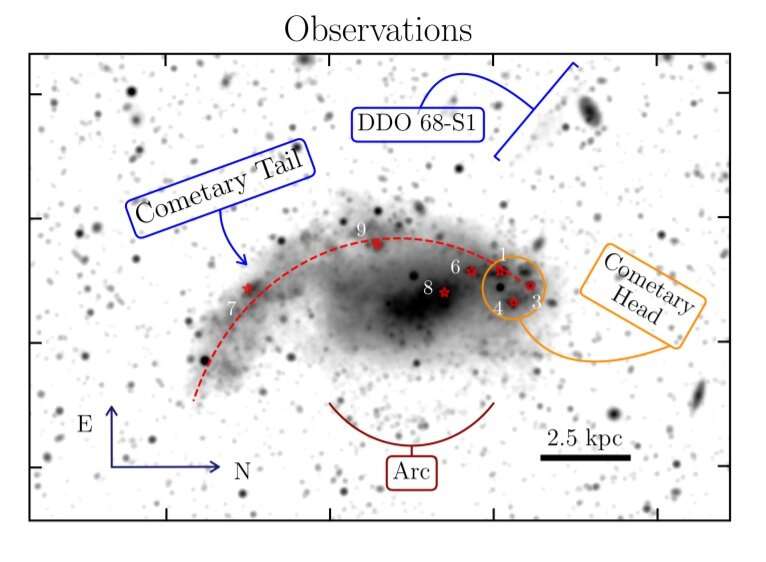November 2, 2021 report
Researchers explore the extremely metal-poor galaxy DDO 68

By performing hydrodynamical simulations, astronomers have investigated an extremely metal-poor galaxy known as DDO 68. Results of the study, presented in a paper published October 25 on the arXiv pre-print server, shed more light on the origin and nature of this peculiar galaxy.
Galaxies with low metallicity are of special importance for astronomers as they could provide crucial insights about chemical evolution of stars and astrophysical processes occurring in the early universe.
At a distance of about 41.2 million light years away from the Earth, DDO 68 (also known as UGC 5340) is a dwarf irregular galaxy. It has a low average oxygen abundance and is one of the most metal-poor dwarf galaxies known to date. Its extremely low metallicity is peculiar in light of its relatively large total stellar mass (117 million solar masses) and luminosity.
Previous observations of DDO 68 have shown that it has an unusual shape. The galaxy showcases a large, bright and distorted stellar component, dubbed the "cometary tail," emerging from the south-eastern edge of its main body. Moreover, it has a roundish structure to the north, the so-called "cometary head." Astronomers found that DDO 68 is, in fact, composed of two distinct systems: the main body DDO 68 A (including the cometary head) and a disrupted satellite DDO 68 B being currently accreted by DDO 68 A and producing the cometary tail.
A team of astronomers led by Raffaele Pascale of the Astronomical Observatory of Bologna, Italy, took a closer look at DDO 68 and its peculiarities. They performed hydrodynamical N-body simulations of DDO 68 aimed at reproducing most of the available structural and kinematical observations of this galaxy derived in the past years.
"We have presented state-of-the-art hydrodynamical N-body simulations able to explain most of the peculiarities observed in DDO 68," the researchers state.
The N-body model reproduced several known features of DDO 68, mainly the very asymmetric and disturbed shape of the stellar component, the overall neutral atomic hydrogen (HI) distribution and its velocity field, the arc-like stellar structure to the west, as well the low-surface brightness stellar stream observed to the north.
Based on the simulations, the astronomers found that the galaxy is most likely a result of the interaction between three systems, namely a dominant galaxy, DDO 68, with a dynamical mass at a level of 10 billion solar masses and two smaller satellite galaxies—with masses of about 0.05 and 0.0067 times the mass of DDO 68.
The researchers therefore concluded that the irregularities observed throughout DDO 68 are not due to an interaction with a smaller companion as DDO 68 C, and are more probably the result of multiple accretion of smaller systems.
"According to cosmological simulations it is not surprising that galaxies as DDO 68 can host satellite galaxies of smaller mass. Indeed, dwarf galaxies in isolation or in low-dense environments would be less susceptible to potential disruptive interactions such as those that dwarf galaxies of the same mass but close to more massive hosts would experience," the authors explained.
More information: R. Pascale et al, Dancing in the void: hydrodynamical N-body simulations of the extremely metal poor galaxy DDO 68. arXiv:2110.13175v1 [astro-ph.GA], arxiv.org/abs/2110.13175
© 2021 Science X Network



















